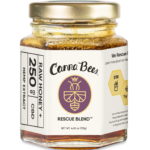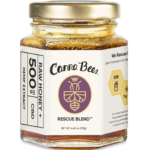Honey bees, ants, termites and wasps share something in common; they are all considered eusocial insects. Eusociality is one of the highest evolved forms of social behavior in which the following defining characteristics exist:
1) Reproductive division of labor: most individuals will not reproduce and instead specialize in colony growth, maintenance and defense.
2) Cooperative brood care: individuals within the colony will care for offspring that are not their own.
3) Overlapping generations: offspring will contribute to colony labor while their mothers are still alive and inside the colony.
Let’s go ahead and apply the above characteristics to our beloved honey bees.

REPRODUCTIVE DIVISION OF LABOR
Each honey bee colony consists of a queen (reproductive female), workers (non-reproductive females), and drones (males). Can you spot the queen pictured above? Each has a clearly defined role that is not performed by any of the others. Hence, they demonstrate a reproductive division of labor. Workers demonstrate cooperative brood care by tending to the queen’s offspring with no offspring of their own. For several years, Honey bee queens can coexist in the colony with their overlapping generations of offspring (workers and drones), which only live for several weeks to several months depending on the time of year.
Honey bees have several different castes that make up their social structure. These castes include queens, workers, and drones. The queen is responsible for mating and producing all the offspring in the colony. She also produces the “Queen Mandibular Pheromone” which she feeds to her workers, who in turn, share it with the rest of the colony. This pheromone gives the colony a sense of oneness or belonging, which holds the colony together as a whole.
COOPERATIVE BROOD CARE
Workers perform all brood care, hive maintenance, and hive defense tasks in their colony. Rather than specializing in one job only, each worker progresses through colony tasks in an order defined by age. For example, young workers take care of the queen and feed the larvae while older worker bees conduct most of their activities outside the hive. This age-based progression is called temporal polyethism.

It’s also a very common misperception that drones (male bees) don’t play an important role in the colony due to the fact that they don’t collect resources, defend, or perform any other colony maintenance related tasks. This couldn’t bee further from the truth. Drones are responsible for passing the colony’s genes on to the next generation by mating with queens from other colonies.
Consider honey bees a “Super organism”, which simply put, means that the whole colony functions as a single organism. You can compare a single bee with a single cell within your own human body. Just as all the cells within your body work together to create a functional human, all the bees within a hive work together to create a functional colony. A few great examples of this would be respiration, thermoregulation and reproduction.
THERMOREGULATION
Did you know that bees are air conditioning masters? When the ambient air temperature outside the hive rises above 93 degrees Fahrenheit, the worker bees will fan air over droplets of water causing evaporative cooling. Conversely when the ambient air temperature outside the hive drops below 93 degrees Fahrenheit the bees will cluster around the brood nest and vibrate their wing muscles to generate heat. A single bee is considered cold blooded but the colony super organism would be considered warm blooded due to its ability to maintain a specific temperature despite changes in the ambient air temperature outside the hive.

Take a big deep breath, hold it in, and now let it out – that’s called respiration. Honey bees perform respiration on an individual level but also at the colony super organism level. A colony often nests inside of cavities such as a tree knot or possibly even the grill in your back yard. Because there is very little passive air exchange in and out of such a cavity, workers are required to fan air into and out of the cavity in distinct inhalations and exhalations through the hive entrance in order for the colony as a whole to breathe.
MATING AND SWARMING
And finally, let’s talk about the birds and the bees. When all the bees are moving in collective harmony and thriving, often a colony can grown too large for its own home and resources. Half the colony and its current queen leave the hive in search of a new home. Those remaining bees rear a new queen that will mature and eventually leave the hive to mate with drones in the surrounding area. The new queen will return to the hive once she is mated and pick up where the original queen left off. This process of one hive splitting in two hives is called swarming.
Instead of every single bee, consider that every colony has its own unique personality and quarks. There is a sense of selfless sacrifice and pride-less contribution in their collective survival.
How different would the world bee if humans always worked together in the same selfless way that honey bees do?
At Bee Delightful, we vibe with a conscious hive. Without conscientious consumers who call the rescue operators, the bees might get exterminated. Without the support of our customers, Bee Delightful couldn’t ensure these at-risk colonies get relocated to apiaries exclusively practicing treatment-free beekeeping. Without our treatment-free beekeepers, we wouldn’t be able to enjoy the cleanest pesticide-free wildflower honey on the market. And without healthy, thriving bees, we lose access to 1/3 of the foods we’ve all grown accustomed to. We’ve all got to work together and treat our world as one super social organism!




